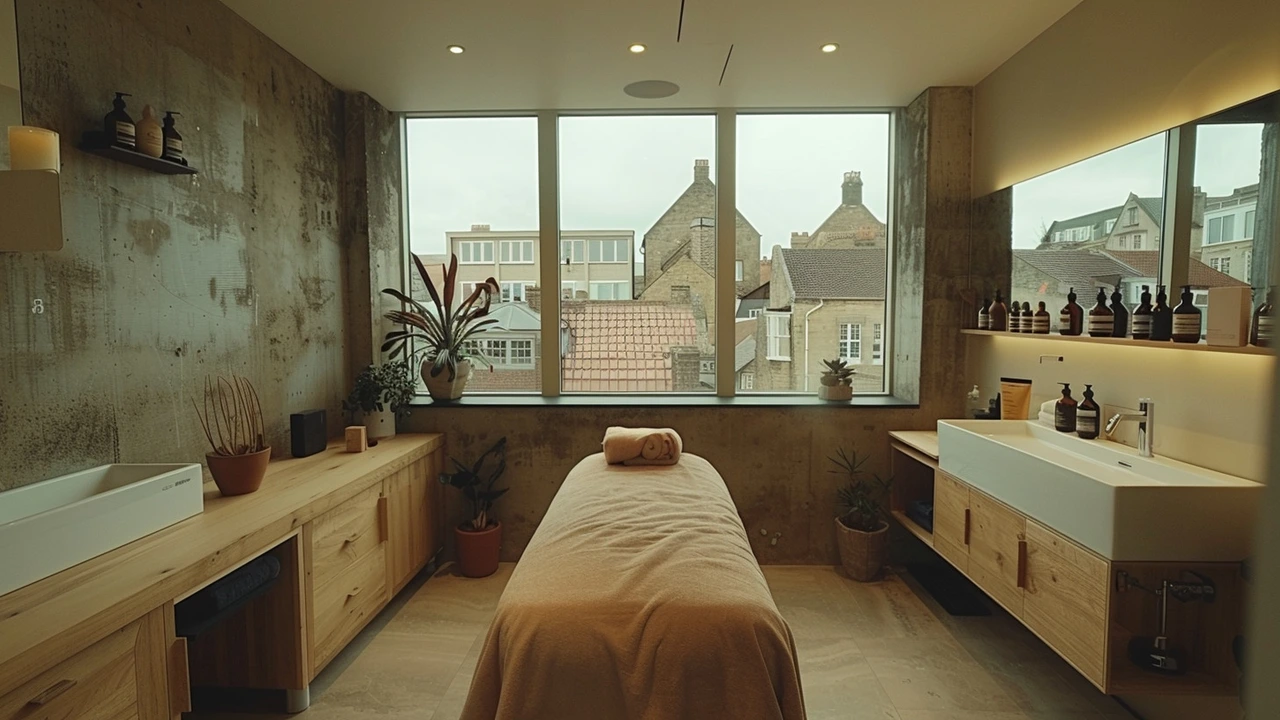Discovering Hellerwork: The New Age of Body Therapy

In recent years, Hellerwork has emerged as a popular body therapy, blending structural integration with movement education and emotional awareness. At its core, Hellerwork aims to address the root causes of physical discomfort and poor posture, offering holistic solutions that enhance overall well-being.
This therapy method was developed by Joseph Heller, an aerospace engineer turned body therapist, who combined his knowledge of structural engineering with a deep understanding of the human body. Hellerwork’s unique approach not only focuses on body alignment but also the emotional and mental aspects of pain and tension.
With its comprehensive techniques, Hellerwork aims to help individuals achieve a balanced and harmonious state by realigning the body's structure, fostering better movement patterns, and promoting emotional healing. It's a transformative experience for many, leading to improved posture, pain relief, and an increased sense of body awareness.
- Understanding Hellerwork
- The Threefold Approach
- Benefits of Hellerwork
- Common Techniques and Tips
- Personal Experiences and Success Stories
Understanding Hellerwork
Hellerwork is a distinctive form of body therapy that delves into the intricate relationship between body alignment, movement, and emotional well-being. Created by Joseph Heller, a former aerospace engineer, Hellerwork combines principles from structural integration and applies them to human physiology. This holistic therapy addresses not just the physical manifestations of pain and tension but also emphasizes emotional and mental healing.
Joseph Heller's journey to developing this therapy is quite fascinating. Dissatisfied with the conventional understanding of bodily mechanics prevalent in his time, he turned his analytical mind towards the human body. His training under Ida Rolf, the founder of Rolfing Structural Integration, significantly influenced his approach. Heller expanded on Rolf's ideas, incorporating movement education and emotional awareness into his practice.
The basis of Hellerwork lies in the belief that the body's fascia, a connective tissue surrounding muscles, can hold emotional and physical tension. Over time, this tension can lead to chronic pain, poor posture, and movement issues. Hellerwork aims to release this tension through a structured protocol of hands-on bodywork, guided movement lessons, and dialogues that explore emotional states.
Dr. Robert Schleip, a prominent fascia researcher, has pointed out that,
The fascial network is not just a passive structure but an active communicator in the body's biomechanics.Such insights underscore the rationale behind therapies like Hellerwork, which proposes that understanding and addressing fascia can lead to a host of benefits.
This therapy is structured into a series of sessions where each focuses on a specific part of the body, promoting alignment and balance. Clients are guided through exercises and movements that help reinforce the benefits of the bodywork. It's a collaborative process, with the therapist and client working together to achieve lasting change. The emotional component involves discussions and techniques aimed at uncovering and releasing pent-up emotions that may be contributing to physical discomfort.
In summary, Hellerwork offers a comprehensive solution to those seeking relief from chronic pain, poor posture, or movement restrictions. By focusing on the interconnectedness of body, mind, and spirit, it allows for profound transformations that resonate beyond the physical realm. The success stories from those who've undergone Hellerwork are testament to its efficacy and revolutionary approach to body therapy.
The Threefold Approach
Hellerwork's threefold approach sets it apart from other body therapies. This method combines structural integration, movement education, and emotional awareness to create a holistic healing experience. Joseph Heller, the founder, believed that addressing all three aspects simultaneously leads to more profound and lasting improvements in an individual's health and well-being.
Firstly, structural integration targets the body's alignment by working on the fascia, the connective tissue throughout the body. Through a series of deep-tissue massages and manipulations, therapists aim to realign the body and improve posture. This part of the therapy helps to alleviate chronic pain and tension, promoting better movement and fluidity in the body.
Movement education is the second component of Hellerwork. This aspect focuses on teaching individuals how to move their bodies correctly and efficiently. By understanding and practicing proper movement patterns, one can prevent injuries and maintain the benefits from the structural work. Movement education often includes activities like walking, sitting, and standing postures, as well as exercises tailored to individual needs.
Lastly, emotional awareness is an integral part of the Hellerwork approach. Many physical issues are rooted in emotional stress and trauma. By addressing these emotional aspects, clients can release long-held tension and pain. Sessions might include guided conversations, breathing exercises, and mindfulness techniques to help individuals connect their emotions with their physical experiences.
Dr. Joseph Heller once said,
"Our bodies are living narratives. To change the way we feel, we must first understand the stories we carry."This quote underlines the importance of integrating emotional awareness with physical therapy. Many clients report significant emotional breakthroughs during their Hellerwork sessions, which contribute to overall healing.
Combining all three elements—structural integration, movement education, and emotional awareness—Hellerwork offers a comprehensive treatment that addresses the whole person. A balanced approach ensures that improvements are not just superficial but deeply rooted in both physical and emotional health. This way, the benefits are sustained and can lead to transformative changes in an individual’s life.

Benefits of Hellerwork
Hellerwork offers a variety of benefits that go beyond simple pain relief, addressing both physical and emotional aspects of well-being. One of the key advantages is improved posture. By realigning the body’s structure through specific techniques, many people notice a significant improvement in their posture over time. This isn’t just about standing or sitting up straight; it can lead to less strain on the body and a reduction in chronic pain caused by poor alignment.
Another important benefit is the potential for pain relief. Many individuals who undergo Hellerwork report a decrease in chronic pain, particularly in areas such as the back, neck, and shoulders. This is achieved by releasing deep-seated tension and stress within the body’s connective tissues, helping to resolve the underlying issues rather than just treating symptoms.
Hellerwork also encourages greater emotional balance. The sessions often include dialogue that helps clients explore and understand the emotional factors contributing to their physical discomfort. This holistic approach can lead to increased emotional awareness and release old emotional patterns that have manifested physically.
Margaret Rolf, a renowned physical therapist, notes, “Hellerwork provides a revolutionary approach to addressing the emotional and physical components of pain. By integrating movement and structural work, it offers a comprehensive path to healing.”
Beyond these benefits, Hellerwork can enhance body awareness. As clients learn more about their own body mechanics and movement patterns, they become more mindful of how they use their bodies in daily activities. This increased awareness can help prevent future injuries and maintain the benefits achieved during sessions.
Lastly, Hellerwork often promotes an overall sense of well-being. The combination of physical adjustments, emotional releases, and movement education creates a holistic experience that many find deeply transformative. People often leave sessions not only feeling better physically, but also with a heightened sense of clarity and relaxation.
Common Techniques and Tips
One of the core components of Hellerwork is the emphasis on structural integration through a series of deep tissue massages. These massages are designed to release tension and realign the body's connective tissues, also known as fascia. Skilled practitioners use their hands, elbows, and sometimes specially designed tools to apply precise, sustained pressure to specific areas of the body. This approach aims to break up fascial adhesions and restore flexibility and movement. This process can be intense, but it is highly effective in relieving chronic pain and discomfort.
Movement education is another key element. Practitioners guide clients through various exercises and movements to improve their body awareness and posture. These exercises are tailored to the individual's needs, addressing specific areas of imbalance or tension. Clients learn how to move more efficiently and ergonomically, reducing the risk of injury and strain. This education extends beyond the therapy sessions, as clients are encouraged to incorporate these new movement patterns into their daily lives for lasting benefits.
Emotional awareness and connection play a significant role in Hellerwork. As physical tension can often be linked to emotional stress or trauma, addressing these underlying issues is crucial for comprehensive healing. Practitioners may use techniques such as guided imagery, mindfulness, and verbal dialogue to help clients explore and release emotional blockages. This holistic approach fosters a deeper understanding of the mind-body connection, promoting long-term well-being.
In addition to these core techniques, there are several practical tips to enhance the benefits of Hellerwork. Regular stretching and flexibility exercises can help maintain the improvements achieved through therapy. Hydration is also essential, as it supports the health of connective tissues and aids in the detoxification process. Practicing good posture and ergonomics in daily activities, such as sitting, standing, and lifting, can prevent the recurrence of stress and strain on the body. Taking time for relaxation and self-care, including practices like meditation and deep breathing, can further support the healing process.
“Hellerwork is a powerful modality that combines physical, emotional, and mental healing to create a balanced, pain-free life.” - Joseph Heller

Personal Experiences and Success Stories
When it comes to understanding the true impact of Hellerwork, nothing is more telling than the personal journeys of those who have undergone this transformative therapy. Numerous individuals have shared their experiences, highlighting the profound changes they have noticed in their bodies and minds.
Take, for instance, Maria, a dedicated runner who suffered from chronic lower back pain. She discovered Hellerwork while seeking a solution beyond traditional physical therapy. After just a few sessions, Maria noticed a significant reduction in her discomfort. Her therapist focused on realigning her posture and addressing the emotional stress contributing to her pain. By the end of her treatment, Maria not only ran pain-free but felt more attuned to her body’s needs.
“Hellerwork changed the way I move and feel. It's like my body found its natural rhythm again. I can’t thank my therapist enough,” Maria shared.
Another compelling story is that of John, a software engineer, who experienced severe neck strain from long hours at his desk. His Hellerwork sessions centered on posture correction and repetitive strain reduction. By incorporating tailored movement exercises and deep tissue work, John reported a remarkable improvement in his flexibility and reduced neck pain. He learned to integrate simple exercises into his daily routine, improving his overall well-being.
For many, the emotional component of Hellerwork has been a game-changer. Jessica, a professional dancer, found solace in addressing not just her physical aches but also the emotional tension tied to her demanding career. Her Hellerworker helped her explore the connection between her emotional state and her muscle tension. Jessica described the experience as liberating, providing her with tools to maintain both physical and emotional balance.
Studies have shown the effectiveness of integrative therapies like Hellerwork. For instance, a research study conducted by the International Journal of Therapeutic Massage and Bodywork reported that participants who underwent structural integration therapies like Hellerwork experienced significant improvements in mobility and pain reduction.
In addition to individual stories, there are holistic success stories from wellness centers that have integrated Hellerwork into their programs. These centers report high levels of client satisfaction and positive outcomes, positioning Hellerwork as a key component of their therapeutic services.
If you’re considering trying Hellerwork, practitioner directories and client reviews can provide insights into finding the right therapist for you. Engaging with community forums where people share their Hellerwork experiences can also be a helpful step in making an informed decision. Ultimately, the success stories of others are a testament to the powerful benefits that Hellerwork can offer, promising not just relief but a pathway to a more aligned, harmonious life.





